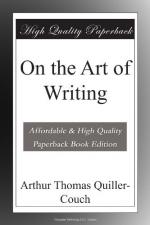It finds out what it
cannot do,
And then it goes and
does it.
I am journeying, say, in the West of England. I cross a bridge over a stream dividing Devon from Cornwall. These two counties, each beautiful in its way, are quite unlike in their beauty: yet nothing happened as I stepped across the brook, and for a mile or two or even ten I am aware of no change. Sooner or later that change will break upon the mind and I shall be startled, awaking suddenly to a land of altered features. But at what turn of the road this will happen, just how long the small multiplied impressions will take to break into surmise, into conviction—that nobody can tell. So it is with poetry and prose. They are different realms, but between them lies a debatable land which a De Quincey or a Whitman or a Paul Fort or a Marinetti may attempt. I advise you who are beginners to keep well one side or other of the frontier, remembering that there is plenty of room and what happened to Tupper.
If we restrict ourselves to the terms ‘verse’ and ‘prose,’ we shall find the line much easier to draw. Verse is memorable speech set down in metre with strict rhythms; prose is memorable speech set down without constraint of metre and in rhythms both lax and various—so lax, so various, that until quite recently no real attempt has been made to reduce them to rule. I doubt, for my part, if they can ever be reduced to rule; and after a perusal of Professor Saintsbury’s latest work, “A History of English Prose Rhythm,” I am left doubting. I commend this book to you as one that clears up large patches of forest. No one has yet so well explained what our prose writers, generation after generation, have tried to do with prose: and he has, by the way, furnished us with a capital anthology—or, as he puts it, with ’divers delectable draughts of example.’ But the road still waits to be driven. Seeking practical guidance—help for our present purpose—I note first that many a passage he scans in one way may as readily be scanned in another; that when he has finished with one and can say proudly with Wordsworth:—
I’ve measured
it from side to side,
’Tis three feet
long and two feet wide,
we still have a sensation of coming out (our good master with us) by that same door wherein we went; and I cannot as yet after arduous trial discover much profit in his table of feet—Paeons, Dochmiacs, Antispasts, Proceleusmatics and the rest—an Antispast being but an iamb followed by a trochee, and Proceleusmatic but two pyrrhics, or four consecutive short syllables—when I reflect that, your possible number of syllables being as many as five to a foot, you may label them (as Aristotle would say) until you come to infinity, where desire fails, without getting nearer any rule of application.
Let us respect a genuine effort of learning, though we may not detect its immediate profit. In particular let us respect whatever Professor Saintsbury writes, who has done such splendid work upon English verse-prosody. I daresay he would retort upon my impatience grandly enough, quoting Walt Whitman:—




